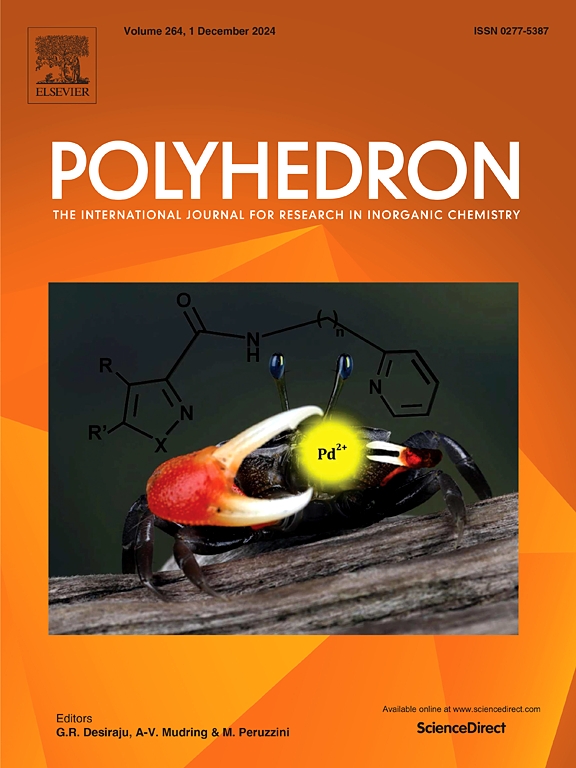一种新型铀酰(VI)配合物的合成、表征和多功能应用:四氢- 4h -铬合成的催化活性、葡萄糖氧化和抗菌性能
IF 2.4
3区 化学
Q2 CHEMISTRY, INORGANIC & NUCLEAR
引用次数: 0
摘要
本研究研究了由三齿配体[HL]衍生的铀酰(VI)配合物[UO2(L)(DMF)2]的合成、表征和多方面应用。利用元素分析、1H NMR、FT-IR、UV-Vis光谱、电导率测量和单晶x射线衍射等技术对合成的配合物进行了全面表征。x射线晶体学揭示了铀(VI)中心周围的五边形双锥体几何结构,配体通过O, N和O '供体原子与金属配位。其余的配位位点由两个氧基和两个DMF分子占据。循环伏安法的电化学研究揭示了U(VI)对U(V)的准可逆还原。Hirshfeld表面分析强调了显著的分子间相互作用,包括Br···Br卤素键,驱动了超分子结构。该配合物对四氢- 4h -铬烯衍生物的合成具有良好的催化活性,在优化条件下(催化剂用量为8 mol%,温度为40°C),收率高达94%,具有良好的可重复使用性。此外,该配合物在温和条件下对葡萄糖氧化为葡萄糖酸表现出优异的催化性能,在碱性介质中达到98%的转化率。提出的机制包括半缩醛中间体的形成,随后由铀酰络合物介导的催化脱氢。此外,与游离的[HL]配体相比,[UO2(L)(DMF)2]对革兰氏阳性(金黄色葡萄球菌、蜡样芽孢杆菌)和革兰氏阴性(大肠杆菌、铜绿假单胞菌)细菌的MIC-30和MIC-50值均显著降低,显示出显著增强的抗菌活性。本文章由计算机程序翻译,如有差异,请以英文原文为准。

Synthesis, characterization, and multifunctional applications of a novel uranyl(VI) complex: Catalytic activity in synthesis of tetrahydro-4H-chromenes, glucose oxidation, and antimicrobial performance
This study investigates the synthesis, characterization, and multifaceted applications of the uranyl(VI) complex [UO2(L)(DMF)2], derived from a tridentate ligand [HL]. The synthesized complex was thoroughly characterized using various techniques, including elemental analysis, 1H NMR, FT-IR, UV–Vis spectroscopy, conductivity measurements, and single-crystal X-ray diffraction. X-ray crystallography revealed a pentagonal bipyramidal geometry around the uranium(VI) center, with the ligand coordinating to the metal through O, N, and O’ donor atoms. The remaining coordination sites are occupied by two oxo groups and two DMF molecules. Electrochemical studies using cyclic voltammetry revealed quasi-reversible U(VI) to U(V) reduction. Hirshfeld surface analysis highlighted significant intermolecular interactions, including Br···Br halogen bonding, driving the supramolecular structure. The complex exhibited excellent catalytic activity in the synthesis of tetrahydro-4H-chromene derivatives, achieving high yields (94 %) under optimized conditions (8 mol% catalyst, 40 °C) with excellent reusability. Additionally, the complex exhibited excellent catalytic performance in the oxidation of glucose to gluconic acid under mild conditions, achieving a 98 % conversion yield in an alkaline medium. The proposed mechanism involves the formation of a hemiacetal intermediate, followed by catalytic dehydrogenation mediated by the uranyl complex. Furthermore, [UO2(L)(DMF)2] demonstrated significantly enhanced antibacterial activity compared to the free [HL] ligand, as evidenced by significantly lower MIC-30 and MIC-50 values, against both Gram-positive (Staphylococcus aureus, Bacillus cereus) and Gram-negative (Escherichia coli, Pseudomonas aeruginosa) bacteria.
求助全文
通过发布文献求助,成功后即可免费获取论文全文。
去求助
来源期刊

Polyhedron
化学-晶体学
CiteScore
4.90
自引率
7.70%
发文量
515
审稿时长
2 months
期刊介绍:
Polyhedron publishes original, fundamental, experimental and theoretical work of the highest quality in all the major areas of inorganic chemistry. This includes synthetic chemistry, coordination chemistry, organometallic chemistry, bioinorganic chemistry, and solid-state and materials chemistry.
Papers should be significant pieces of work, and all new compounds must be appropriately characterized. The inclusion of single-crystal X-ray structural data is strongly encouraged, but papers reporting only the X-ray structure determination of a single compound will usually not be considered. Papers on solid-state or materials chemistry will be expected to have a significant molecular chemistry component (such as the synthesis and characterization of the molecular precursors and/or a systematic study of the use of different precursors or reaction conditions) or demonstrate a cutting-edge application (for example inorganic materials for energy applications). Papers dealing only with stability constants are not considered.
 求助内容:
求助内容: 应助结果提醒方式:
应助结果提醒方式:


